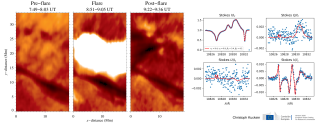The Sun is well known for its magnetic activity, including periodic flares that rise from its surface when magnetic field lines tangle, cross or reorganise near sunspots. Flares send streams of charged particles into space. If they are directed towards Earth, these particles can disrupt satellites or cause colourful auroral displays. The EU-funded CHLARE project aims to enhance understanding of solar flares and related solar events in the chromosphere, where studies are scarce.
The project will upgrade the existing inversion code to interpret flare physics in the spectral region of He I 1083.0 nm triplet and make it freely available. The work will be complemented by hydrodynamic simulations, and the project's results will provide a valuable foundation for analysing solar flares and space weather.

